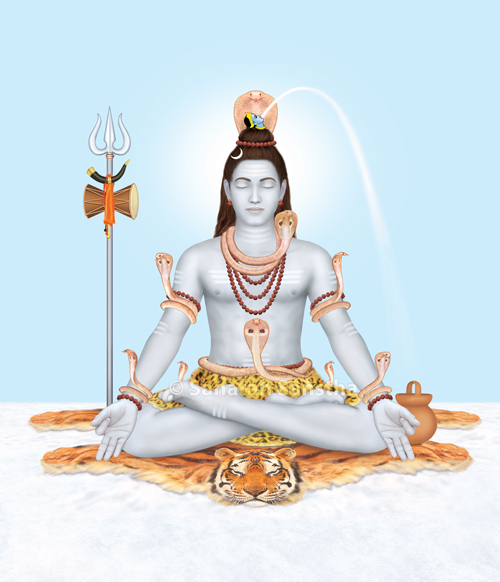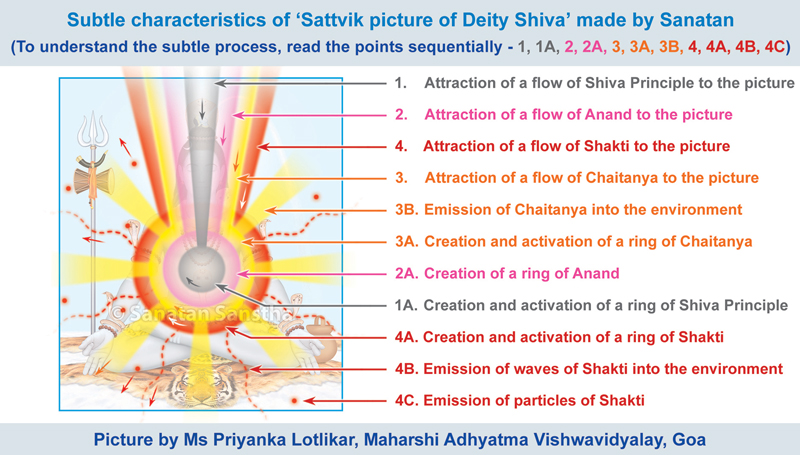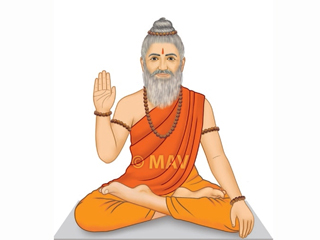 Supreme Shiva is the conductor of the five actions in the Universe – Srushti (Creation), Sthiti (Sustenance), Samhar (Annihilation), Anugraha (Grace) and Vilaya (Dissolution). This Universe is a reflection of the Supreme Shiva. Shiva is Absolute, self-radiant. He remains radiant and illuminates the Universe.
Supreme Shiva is the conductor of the five actions in the Universe – Srushti (Creation), Sthiti (Sustenance), Samhar (Annihilation), Anugraha (Grace) and Vilaya (Dissolution). This Universe is a reflection of the Supreme Shiva. Shiva is Absolute, self-radiant. He remains radiant and illuminates the Universe.

Let us understand some special spiritual aspects in worshipping Deity Shiva that will strengthen our faith in Him.
Mahashivaratra
On the day of Mahashivaratra, Deity Shiva’s Principle is a thousand times more active when compared to other days. To benefit most from the Shiva Principle on this day, chant || Om Namaha Shivaya || as much as is possible and worship Deity Shiva with bhav (Spiritual emotion).
Science in the worship of Deity Shiva on Mahashivaratra
The function of the ‘Shivapindi’
A. Emitting waves of Knowledge, Devotion and renunciation : Predominantly Sattva (Spiritually pure) waves of knowledge, Raja waves of devotion and Tama waves of renunciation are emitted by the Shivapindi. During Mahashivaratra, the emission increases by 30 per cent.
B. Emission of subtle vibrations of Chaitanya (Divine consciousness), Anand (Bliss) and Shanti (Peace) : The Shivapindi emits subtle vibrations of Chaitanya, Anand and Shanti. During Mahashivaratra, the emission increases by 25 per cent. This helps purify the subtle-body of the one who worships the Shivapindi on this day. The Sun or the Moon channels in the body get activated as per the need. The capacity to absorb the Sattva component and Chaitanya also increases. Due to the presence of the unmanifest Shiva Principle in the Shivapindi and the vibrations of Shanti emitted, the Shivapindi remains cool, and the mind too experiences Shanti. Worship of the Shivapindi with devotion activates the dormant Shiva Principle.
C. Receiving the taraktattva or maraktattva as required : There is a confluence of the manifest and unmanifest Principles along with the taraktattva and maraktattva in the Shivapindi (Tarak – Saviour; Marak – Destroyer). This is how worshippers receive the required Principle. The temperature of the Shivapindi rises due to the emission of the maraktattva and then, one experiences Anand. When taraktattva is emitted, the temperature drops and one experiences Shanti and Anand.
Spiritual science underlying offering bel leaves to Shiva
The basic nature of a worshipper corresponds to the tarak form and hence, worship of Shiva’s tarak form not only blends with their nature, but also helps in their spiritual progress. To benefit from the tarak waves of Deity Shiva, worshippers should offer bel leaves with the stalk towards the pindi and the upper portion (tip) of the leaf towards themselves.
When we offer a bel leaf with its stalk towards the pindi and the tip towards us, the spread of Shiva Principle through the tip of bel leaf is more. One obtains the benefit of the Shiva Principle at the samashti (Society) level. Conversely, when the bel leaf is offered with its stalk towards us and the tip towards the pindi, the Shiva Principle is obtained only by the individual who offers the leaf. Here, the benefit of the Shiva Principle is obtained at the vyashti (Individual) level.
When the bel leaves are offered upside down on the Shivapindi, the vibrations at the unmanifest level are emitted to a larger extent from them. The worshipper gets maximum benefit from the bel leaves.
If fresh bel leaves are not available, old leaves can be used; however, the bel leaves plucked on a Monday cannot be used the next day.
Tulsi (Holy basil) leaves are not offered to Shiva. However, tulsi leaves offered to a Shaligram or an Idol of Shri Vishnu first, may be offered to Shiva. (Shiva considers Shri Vishnu to be His Guru. He is a devotee of Shri Vishnu. So He adores the tulsi leaves offered to Shri Vishnu.)
The constantly falling stream of water
Since Shiva and Shakti are together in the pindi, a tremendous amount of heat is generated. To prevent radiance from having adverse effects on the pavitrakas of the pindi and on its worshippers, a continuous stream of water is made to fall upon the pindi. This stream of water generates the sound of ‘Om’ (A symbol of the unmanifest Brahman) of a low note.
When a continuous stream of mantras falls on a jivatma (Embodied soul performing spiritual practice), it opens the kalapinda (A subtle-body [pinda] that has crossed the limitations of time) of the jiva. This indicates that one can go up to the unmanifest Brahman.
Special characteristics of rudraksha
Rudraksha (seed) takes its radiance from the atmosphere and converts it into oil. If we chant II Om Namaha Shivaya II sitting under a rudraksha tree, fragrant oil will constantly emanate from the rudraksha. This oil will spill out if we blow into the hole of the rudraksha. The oil has a pleasant fragrance and can be extracted from its tree. The rudraksha transforms light waves of Deities in the Universe into sound waves of the human body and vice versa. As a result, man can absorb the waves of Deities and human thoughts can get converted into the language of the Deities.
(Ref. : Sanatan’s Text – Holy festivals, Religious festivals and Vowed religious observances)
Sanatan’s Text on spiritual science underlying worship of Deity Shiva
Every Deity has a specific Science of worship, meaning, there is an underlying science in each specific step of the worship. Performing each action of the worship in an appropriate manner after understanding the science helps the worshipper benefit to the maximum.
With this perspective, various steps such as how should a worshipper apply bhasma (Sacred ash) to himself before worshipping Deity Shiva, which rangoli should be drawn in front of Deity Shiva, which flowers should be offered to Him and in what numbers, the incense-stick of which fragrance is to be waved in front Him, which fragrance must be offered to Him, etc. have been elucidated in this Spiritual text.
This will help not only the devotees who worship Deity Shiva daily, but also devotees who observe vrats (Vowed religious observances) and celebrate festivals such as Solaha-Somvar, Shravan-Somvar, Shivamutha, Haritalika, Mahashivaratra.
Some important aspects : Applying bhasma, Adorning rudraksha, Shrunga-darshan (viewing the Shivalinga through Nandi’s horns), For having direct darshan of the pindi, not standing or sitting between the pindi and Nandi, but standing beside the line joining the pindi and Nandi, Ritualistic worship of the pindi, Prohibition on use of turmeric and kumkum, Why offer bel to Deity Shiva, etc.
Some rangolis that attract and emit Shiva Principle
In Hindu Dharma, rangoli is drawn during every festival, auspicious occasion, religious ritual, etc. The rangoli patterns given here attract and emit Shiva Principle, because of which the environment gets charged with the Shiva Principle and the devotees benefit.
(Different rangoli patterns that attract and emit Principles of various Deities and the colours to be filled in these patterns have been given in Sanatan’s booklet – ‘Sattvik Rangolis’.)
From the dot in the centre, draw 4 dots each in eight directions.



 One Lamp for Hindu Rashtra: a unique initiative by Hindu Janajagruti Samiti on Tripurari Purnima
One Lamp for Hindu Rashtra: a unique initiative by Hindu Janajagruti Samiti on Tripurari Purnima British Prime Minister’s Office apologises to Hindus
British Prime Minister’s Office apologises to Hindus Diwali celebrations held at Capitol Hill following the recent presidential election in the United States
Diwali celebrations held at Capitol Hill following the recent presidential election in the United States Punjab CM Maryam Nawaz celebrated Diwali in Pakistan
Punjab CM Maryam Nawaz celebrated Diwali in Pakistan Diwali celebration in the Parliament of Canada is not banned : Clarification by the Opposition
Diwali celebration in the Parliament of Canada is not banned : Clarification by the Opposition Unique research on the effect on Apta leaf (Mountain ebony) on the day of Dussehra !
Unique research on the effect on Apta leaf (Mountain ebony) on the day of Dussehra !